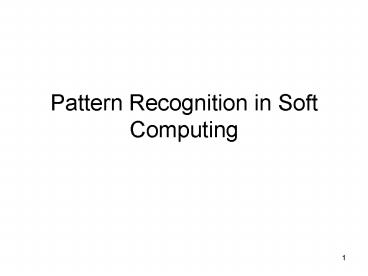Pattern Recognition in Soft Computing - PowerPoint PPT Presentation
1 / 21
Title:
Pattern Recognition in Soft Computing
Description:
Computing paradigm (consortium of complementary ... Specialized Algo. GA. 9. GA. Flowchart. Initialize Population. Terminate? Yes. Output. solution ... – PowerPoint PPT presentation
Number of Views:844
Avg rating:3.0/5.0
Title: Pattern Recognition in Soft Computing
1
Pattern Recognition in Soft Computing
2
Soft Computing
- Computing paradigm (consortium of complementary
methodologies) that is tolerant of imprecision,
uncertainty, partial truth,near-optimality - Goal is to achieve robustness, tractability and
low cost solution.
3
Fuzzy Logic
Approximate reasoning
Neural Networks
Soft Computing
Chaos Theory
Genetic Algorithms
Rough Sets
4
GENETIC ALGORITHMS
- DEFINITION
- Randomized search and optimization technique
guided by the principle of natural genetic
systems. - Why Genetic Algorithms (GAs) ?
- Many real life problems cannot be solved in
polynomial amount of time using deterministic
algorithm - Sometimes near optimal solutions that can be
generated quickly are more desirable than optimal
solutions which require huge amount of time - Problems can be modeled as an optimization one.
5
Search TechniquesThe traditional vs. the
unconventional
- Calculus based techniques gradient descent
- (hill climbing)
local optima
Global optima
Continuous domain, quadratic optimization best
method
6
Search TechniquesThe traditional vs. the
unconventional
- Enumerative technique dynamic
- programming
n points
What if n very very large? Quite likely in
practice.
7
Search TechniquesThe traditional vs. the
unconventional
- Random technique hoping to find the optimal
- sooner.
No better than enumerative in the long run
8
Randomized Algorithms
- Guided random search technique
- Uses the payoff function to guide search
Genetic Algorithms (GAs)
GA
Efficiency
Specialized Algo.
P
Problems
Specialized algorithms best performance for
special problems Genetic algorithms good
performance over a wide range of problems
9
GAFlowchart
10
Encoding and Population - Example
Optimize f(x) x(8 x), x0,8
154
x 8/255 154 0 4.8313
11
Fitness Evaluation - Example
Function f(x) x(8-x)
Chromosome Corresponding x Objective/
Fitness fn.
1 0 0 1 1 0 1 0
4.8313 15.3089
12
Roulette Wheel Selection Example
Chromosome Fitness 1 15.3089 2 15.4091
3 4.8363 4 12.3975
4
3
1
2
Spin
2
1
2
4
Mating Pool
13
Crossover Example
Here l (string length) 8. Let k (crossover
point) 5
Offspring formed
0 1 1 1 1
0 1 0
14
Mutation- Example
15
Pattern Classification
Classification
Supervised
Unsupervised
Presence of labelled data
All data unlabelled
Unsupervised
16
Classification
Feature space
Decision Space
FL
17
GAs for Pattern Classification
- Linear discriminant approach
- Modeling class boundaries using a number of
hyperplanes - Minimize the error.
18
Modeling Class Boundaries Using A Number of
Hyperplanes
N-1 angles a , a , ..., a
Hyperplane in N dimensions
1
2
N-1
Perpendicular distance, d
H
H
H
1
1
1
1
a
a
a
a
d
d
a
N-1
N-1
N-1
N-1
1
1
2
Hyperplane H
Hyperplane 1
19
Value of H
High overfitting the data
Low Poor/Incomplete approximation
20
Evolve H automatically
Solution
Concept of variable string length
Chromosome 2
Fitness n - miss - H/ H
max
n size of training data miss number of
misclassified points H number of
hyperplanes H maximum number of
hyperplanes
max
Note miss has more dominance than H.
21
Fitness Computation
1
2
2
2
2
1
1
2
2
2
1
1
misclassified
1
1
1
2
2
2
n 18 miss 4 H 4 H 8
fitness 18 - 4 - 4/8 13.5
max























![Seminar: CSE 717 Soft[1] Biometric Traits in Face Recognition System PowerPoint PPT Presentation](https://s3.amazonaws.com/images.powershow.com/A1256656026vfqty.th0.jpg?_=20140117078)







